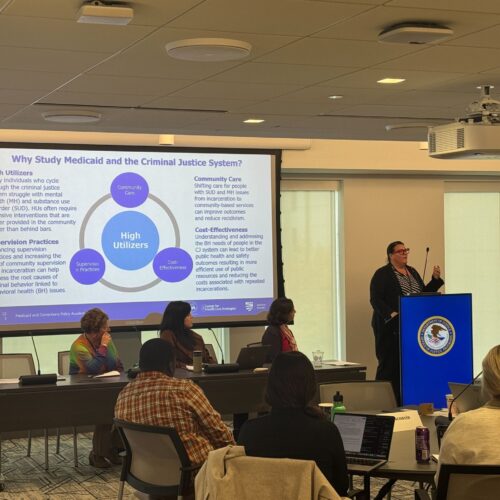Teams from All 50 States Examine Local Criminal Justice Trends at ‘Unprecedented Gathering’
The two-day 50-State Summit on Public Safety, organized by The Council of State Governments (CSG) Justice Center in partnership with the Association of State Correctional Administrators (ASCA), occurred at a time when public safety officials and crime data are telling a complex story. While property crime rates have fallen significantly in almost every state, and the overall violent crime rate remains lower than it was a decade ago, it is no longer universally declining. In fact, violent crime is increasing overall in 18 states and in many individual communities across the country. Further, the opioid epidemic has become a national crisis, and law enforcement leaders describe engaging with more people with serious mental illnesses than ever before.
“The amount of data available, and opinions about what that data means, sometimes makes you feel like you’re drinking from a fire hose. There’s no shortage of action that can be taken as a corrections leader,” said John Wetzel, Secretary of Pennsylvania’s Department of Corrections, who also serves as Chair of the CSG Justice Center and Vice President of ASCA. “This summit is a key opportunity to engage with colleagues across agencies and at all levels of government to better understand that data and accelerate the adoption of programs that truly work.”
Each of the 50 state teams that attended the event on November 13–14 in Washington, DC were led by their respective state corrections administrator and included a key state legislator, a law enforcement official and a local behavioral health professional. Attendees—including 35 behavioral health directors, 15 police chiefs, 12 sheriffs, and 41 state legislators—received state-specific workbooks that highlighted data collected by CSG Justice Center staff in interviews with criminal justice professionals in all 50 states. State data included trends in crime, arrests, recidivism, correctional populations, and behavioral health in each state, as well as discussion questions to help each team think about the public safety challenges in their state and possible solutions.
“The intersection between the criminal justice system and people with mental illness and substance abuse disorders is more prominent than ever before, and local agencies are struggling to meet the demand for services for people in jail and on community supervision,” said Tracy Plouck, Director of the Ohio Department of Mental Health and Addiction services and Vice-Chair of the CSG Justice Center. “This reality reinforces the critical role behavioral health specialists will have in the effort to preserve public safety and get people the treatment they need.”
The summit featured discussions with leaders representing all facets of the criminal justice system from states across the country, as well as national voices, including U.S. Deputy Attorney General Rod Rosenstein, Kentucky Gov. Matt Bevin, and Darlene Hutchinson Biehl, Director of the U.S. Department of Justice’s Office for Victims of Crime.
State teams emerged from the summit having identified clear strategies for reducing crime and recidivism, improving outcomes for people with mental health and substance use disorders, and reducing spending on prisons and jails.
“In order to achieve lasting crime and recidivism reductions, state and local leaders will need to develop a more comprehensive and coordinated public safety strategy that sustains success to date and responds to the unique combination of new challenges in their states,” Arkansas State Representative Clarke Tucker said. “I know that for my team attending the summit, this is a great checkpoint to understand where things stand in our state, reestablish our engagement across different agencies and learn about new opportunities to improve our criminal justice system.”
Following the summit, the U.S. Department of Justice’s Bureau of Justice Assistance will select up to 25 states to receive additional technical assistance from criminal justice experts in early 2018. Attendees were encouraged to apply for this opportunity at the summit. Additionally, the CSG Justice Center will be releasing a report in the coming months that includes a detailed analysis of the state and local data discussed at this week’s summit.
The 50-State Summit on Public Safety was made possible by funding from by the U.S. Department of Justice’s Bureau of Justice Assistance, the John D. and Catherine T. MacArthur Foundation, the Pew Charitable Trusts, and the Tow Foundation.
A positive school experience, where a child feels secure, is essential for their well-being. However, for many children…
Read More The Path to Statewide Community Crisis Response in New Jersey: A Community Advocate’s Perspective
Read More
The Path to Statewide Community Crisis Response in New Jersey: A Community Advocate’s Perspective
Read More
 Supporting Children of Incarcerated Parents: Reimagining School and Community Collaboration
Supporting Children of Incarcerated Parents: Reimagining School and Community Collaboration
A positive school experience, where a child feels secure, is essential for…
Read More Bridging Communities and Correctional Systems: Q&A with CSG Justice Center Advisory Board Member Commissioner Nicholas Deml
Read More
Bridging Communities and Correctional Systems: Q&A with CSG Justice Center Advisory Board Member Commissioner Nicholas Deml
Read More
 Assigned to the Cloud Crew: The National Incarceration Association’s Hybrid Case Management for People with Behavioral Health Needs
Assigned to the Cloud Crew: The National Incarceration Association’s Hybrid Case Management for People with Behavioral Health Needs
When returning to their communities from criminal justice settings, people with behavioral…
Read More Meet the Medicaid and Corrections Policy Academy Mentor States
Meet the Medicaid and Corrections Policy Academy Mentor States
New Hampshire Department of Corrections Commissioner Helen Hanks presents at the Medicaid…
Read More










